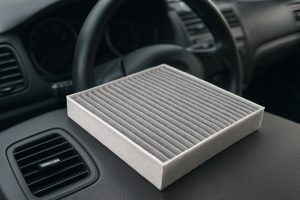When most drivers think about vehicle performance, they focus on the engine, transmission, or brakes. Yet, one of the most overlooked components directly influencing comfort and efficiency is the cabin air filter. This small but crucial part plays a key role in your car’s heating, ventilation, and air conditioning (HVAC) system. A clogged or poor-quality filter can make your HVAC system work harder, reduce airflow, lower fuel efficiency, and even affect the air quality inside your cabin.
What Is a Cabin Air Filter and What Does It Do?

A cabin air filter is a pleated paper or synthetic filter located behind the glove compartment, under the dashboard, or under the hood. Its primary job is to clean the air entering your car’s interior through the HVAC system.
The filter traps:
-
Dust and pollen
-
Soot and smog particles
-
Mold spores and allergens
-
Tiny debris such as leaves or insects
-
Harmful gases (in the case of activated carbon filters)
In other words, it ensures that the air you and your passengers breathe is fresh and clean while keeping the HVAC system free of debris that could block airflow.
How Cabin Filters Influence HVAC Performance
A clean filter allows unrestricted airflow through the HVAC ducts. However, as contaminants accumulate over time, the filter’s resistance increases, forcing the blower motor to work harder. This added strain can reduce system performance and comfort.
| Condition | Airflow | HVAC Efficiency | Cabin Comfort | Fuel Consumption |
|---|---|---|---|---|
| Clean Filter | Optimal | High | Fast heating/cooling | Normal |
| Slightly Dirty Filter | Reduced | Moderate | Slight delay in temperature adjustment | Slightly increased |
| Clogged Filter | Severely restricted | Low | Poor air circulation, weak airflow | Higher due to increased blower demand |
Result: A dirty cabin filter directly impacts HVAC efficiency by limiting airflow, increasing system workload, and consuming more energy.
The Connection Between Airflow and Efficiency
Your car’s HVAC system is designed to move a specific amount of air per minute. When the filter becomes clogged:
-
Blower motor strain increases – leading to premature wear and possible failure.
-
Heating and cooling take longer – especially noticeable in extreme weather.
-
Defogging and defrosting slow down – due to limited warm or cool air reaching the windshield.
-
Fuel efficiency drops – particularly in vehicles with automatic climate control systems that compensate for reduced airflow by running the compressor or fan longer.
Thus, maintaining a clean cabin filter is not only about comfort but also about energy efficiency and mechanical longevity.
Types of Cabin Filters and Their Efficiency
| Type | Filtration Capability | Main Advantage | Recommended Replacement Interval |
|---|---|---|---|
| Standard Paper Filter | Dust, pollen | Affordable and reliable | Every 12,000–15,000 km |
| Activated Carbon Filter | Dust, odors, gases | Removes unpleasant smells and pollutants | Every 12,000–20,000 km |
| HEPA Cabin Filter | Microscopic particles, allergens | Best for sensitive users and polluted environments | Every 15,000–25,000 km |
Choosing the right filter type for your climate and driving conditions can greatly improve HVAC efficiency and cabin air quality.
You can explore high-quality options and buy filters online for your specific car model.
How to Know It’s Time to Replace the Cabin Filter
A cabin air filter doesn’t fail suddenly — it gradually becomes less effective. Here are the most common warning signs:
-
Reduced airflow from vents even at high fan speed
-
Foggy or musty smell inside the car
-
Unusual noises from the fan motor (indicating airflow restriction)
-
Slower heating or cooling performance
-
Dust settling quickly inside the cabin after cleaning
Replacing the filter promptly can prevent damage to your HVAC system and restore efficient operation.
How a Clean Cabin Filter Helps the HVAC System
Keeping the cabin air filter in good condition provides several long-term benefits:
-
Efficient Air Circulation – ensures optimal air pressure throughout the duct system.
-
Less Strain on HVAC Components – reduces wear on blower motors and resistors.
-
Improved Air Conditioning Efficiency – better airflow allows faster cooling.
-
Extended Lifespan of HVAC Components – fewer contaminants reach evaporator coils or sensors.
-
Healthier Cabin Environment – cleaner air means fewer allergens and odors.
Recommended Maintenance Schedule
Most car manufacturers recommend changing the cabin air filter every 12,000–20,000 km or once a year, depending on:
-
Driving environment: Dusty, urban, or industrial areas require more frequent changes.
-
Climate conditions: Humid regions can cause faster mold buildup.
-
Usage pattern: Frequent use of air conditioning or heater accelerates clogging.
Pro Tip: Inspect your cabin filter at least twice a year — at the start of summer and winter — when HVAC usage is highest.
DIY Cabin Filter Replacement (Step-by-Step)
-
Locate the filter housing (usually behind the glove compartment).
-
Remove the cover panel or screws if necessary.
-
Pull out the old filter carefully to avoid spilling trapped debris.
-
Clean the housing area with a damp cloth or mild cleaner.
-
Insert the new filter following the “airflow” arrow direction.
-
Reattach the cover and test your HVAC system.
Replacement usually takes 10–15 minutes and requires no special tools.
Conclusion
Your car’s cabin air filter is much more than a comfort accessory — it’s an essential component of the HVAC system’s efficiency and longevity. A clogged or neglected filter forces your system to work harder, increases fuel consumption, and reduces air quality inside your vehicle.
By maintaining a clean, high-quality cabin filter, you not only breathe cleaner air but also ensure that your HVAC system performs at peak efficiency in all seasons.
If you’re ready to upgrade or replace your filter, you can easily buy filters online to find the perfect fit for your car.